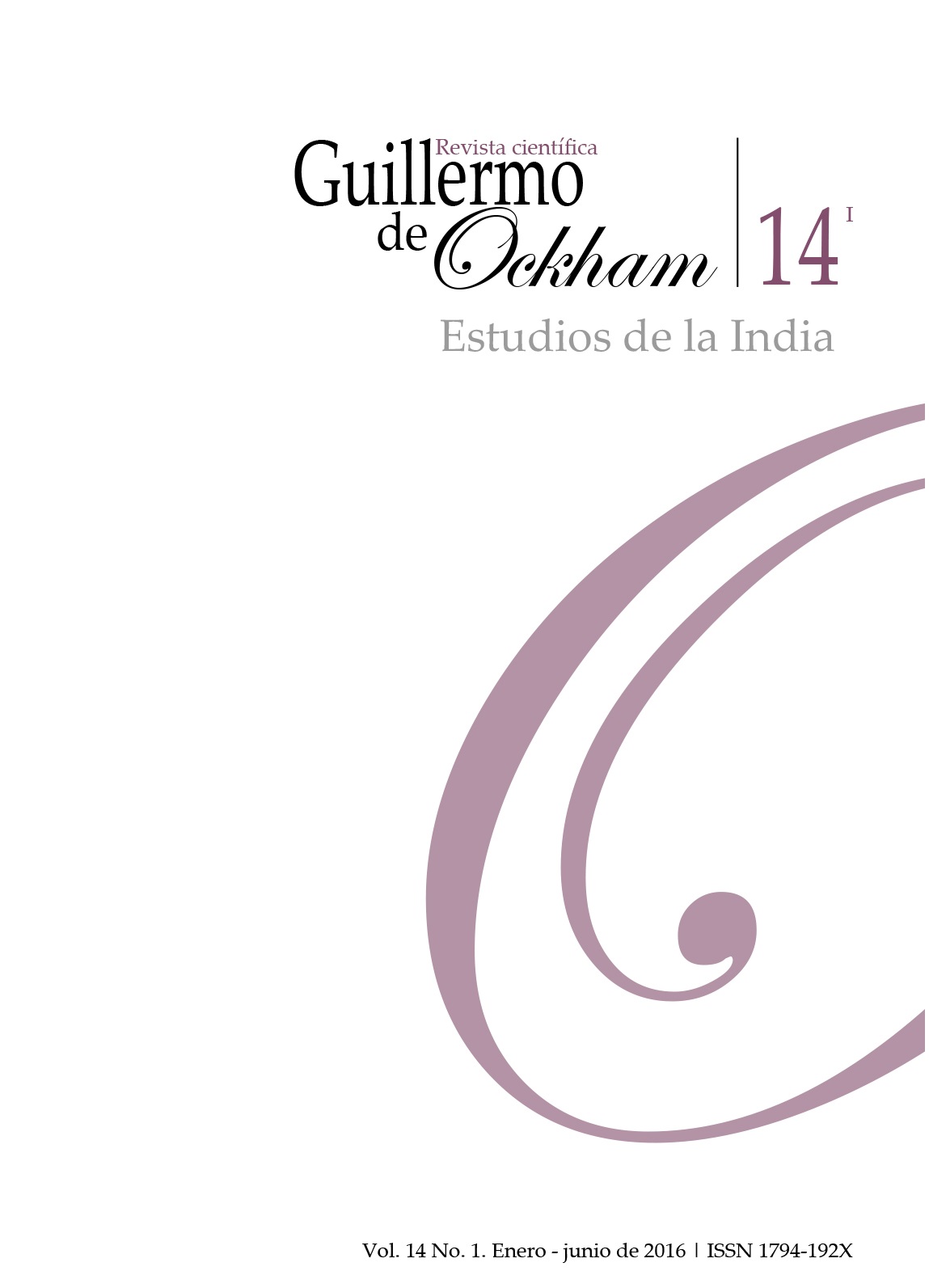The Revista Guillermo de Ockham provides an immediate and open access to its content, based on the principle of offering the public a free access to investigations to provide a global interchange of knowledge.
Unless otherwise established, the contents of this journal has a license with Creative Commons Attribution-NonCommercial-NoDerivatives 4.0 International (CC BY-NC-ND 4.0) http://creativecommons.org/licenses/by-nc-nd/4.0/
- Attribution: You must give appropriate credit, provide a link to the license, and indicate if changes were made. You may do so in any reasonable manner, but not in any way that suggests the licensor endorses you or your use.
- NonCommercial: You may not use the material for commercial purposes.
- NoDerivatives: If you remix, transform, or build upon the material, you may not distribute the modified material.
- No additional restrictions: You may not apply legal terms or technological measures that legally restrict others from doing anything the license permits.
Abstract
De acuerdo a lo señalado por la Organización Internacional para las Migraciones/OIM (2010), se estima que en el presente existen 214 millones de personas viviendo fuera de su país de origen. En ese marco, la denominada diáspora india cuenta con más de 20 millones de personas, fuera de India (Ministry of External Affairs/MEA, 2002). Atendiendo precisamente a las diásporas, Sheffer (1986) apunta que las redes creadas por diásporas étnicas forman parte de una relación triádica que comprende a la diáspora misma, su país de origen y de residencia, señalando además que esa relación deviene un aspecto integral y permanente del flujo de política nacional e internacional. Considerando lo mencionado, el presente trabajo aborda la bibliografía académica producida sobre la relación triádica mencionada y sus componentes, en el marco del estudio de las migraciones en el ámbito internacional, desde 2000. Se revisan los aportes, los elementos a profundizar y los vacíos y se concluye con la propuesta de un abordaje interdisciplinario del fenómeno.
References
Agarwala, R. (2012). Tapping the Indian Diaspora for Indian Development. In A. Portes & P. Fernández - Kelly, (Eds.). The State and the grassroots: Inmigrant Transnational Organization in four continentes (pp. 85-110). NY: Berghahn Books.
Anderson, B. (1993). Comunidades Imaginadas. Reflexiones sobre el origen y la difusión del nacionalismo. México: Fondo de Cultura Económica.
Bal, E., & Sinha-Kerkhof, K. (2007). No “holy cows” in Surinam: India, comunal relations, identity politics, and the Hindostani Diaspora in Surinam. SACS, 1(2), 17-35.
Balasubramanyam, V. N. (2007). The Diaspora and Development. Recuperado de http://goo.gl/RaUKBc
Ballard, R. (Ed.) (1994). Desh pardesh. The South Asian presence in Britain. London: Hurst & Co.
Bhargava, K., Sharma, J. C., & Salehi, S. (2008). Building Bridges: A Case Study on The Role of the Indian Diaspora in Canada. Ontario: The Centre for the Study of Democracy.
Bhat, Ch., & Narayan, K. L. (2010). Indian Diaspora, Globalization and Transnational Networks: The South African Context. J. Soc. Sci, 25 (1-2-3), 13-23.
Bhatt, Ch., & Mukta, P. (2000). Hindutva in the West: mapping the antinomies of diaspora nationalism. Ethnic and Racial Studies, 23(3), 407-441.
Chand, M. (2009). How does the Indian diáspora help drive trade and investment ties between India and North America? An exploratory Study (Tesis de doctorado Inédita). Simon Fraser University, Canada.
Chanda, R. (2008). The Skilled South Asian Diaspora and its role in source economies. South Asian Diaspora. Syngapore: ISAS.
Chanda, R., & Sreenivasan, N. (2006). India’s Experience with Skilled Migration. In C. Kuptsch & E. F. Pang (Eds.), Competing for Global Talent (pp. 215-256). Geneva: International Institute for Labor Studies.
Choudhari, S. K. (2014). Political colonization of multi-ethnic Britain: a study of Indian Diaspora. Diaspora Studies, 7(2), 100-120.
Dhillon, S. (2007). The Sikh Diaspora and the Quest for Khalistan: A Search for Statehood or for Self-preservation? New Delhi: Institute of Peace and Conflict Studies.
Gautam, M. K. (2013). Indian Diaspora: Ethnicity and Diasporic Identity. Italia: European University Institute.
Gayer, L. (2007). The Volatility of the ‘Other’: Identity Formation and Social Interaction in Diasporic Environments. South Asia Multidisciplinary Academic Journal, 1. doi: 10.4000/samaj.36
Gellner, E. (1988). Naciones y Nacionalismo. Madrid: Alianza.
Gottschlisch, P. (2008). The Indian Diaspora in the United States of America: An Emerging Political Force? In P. Raghuram, A. K. Sahoo, B. Maharaj & D. Sangha, D. (Eds.), Tracing an Indian diaspora. Contexts, Memories, Representations (pp.156-170). New Delhi: Sage.
Gupta, A. (2004). The Indian Diaspora’s Political Efforts in the United States. New Delhi: Observer Research Foundation.
Gupta, R. K. (2013). Non.State actors in international relations: a case of Indian diáspora in Africa. Recuperado de http://goo.gl/8xzjBt
Heath, D., & Mathur, Ch. (Eds.) (2011). Communalism and globalization in South Asia and its diáspora. London/NY: Routledge.
Hercog, M., & Siegel, M. (2010). Engaging the diaspora in India (Working Paper Series No. 2011-041). The Netherlands: Maastrich Graduate School of Governance.
Ibarra, L. (Septiembre. 2014). Castas: Identidades que atraviesan fronteras. Trabajo presentado en el Seminario “Perspectivas de cultura y política en la India. Buenos Aires, Argentina.
Jaffrelot, Ch., & Therwath, I. (2007). The Sangh Parivar and the Hindu Diaspora in the West: What Kind of “Long-Distance Nationalism”? International Political Sociology, 1(3), 278-295.
Janardhanam, V. (2013). Political participation of the Indian Diaspora in the USA. Journal of International and Global Studies, 5(1), 16-33.
Kapoor (2003), The Indian Diaspora as a Strategic Asset. Economic and Political Weekly, 38(5), 1-7.
Kapur, D. (2010). Diaspora, development and democracy. The domestic impact of international migration from India. NJ: Princeton University Press.
Khanna, P. (2005). Bollystan: India’s Diasporic Diplomacy. In P. K. Basu, B. Chellaney, P. Khanna & S. Khilnani, S. (Eds.), India as a New Global Leader (pp. 16-26). London: Foreign Policy Centre.
Khory, K. R. (2006). Diaspora Populations, the Internet and olitical Mobilization. In S. Rajagopalan (Ed.), Security and South Asia. Ideas, Institutions and Initiatives (pp. 152-175). New Delhi: Routledge.
Kinnvall, C., & Svensson, T. (2010). Hindu nationalism, diaspora politics and nation-building in India. Australian Journal of International Affairs, 64(3), 274-292.
Lacroix, T. (2011). Indian and Polish Migrant Organisations in the UK (HA archives ouvertes No. halshs- 00820303). Oxford: IMI.
Leclerc, E. (Octubre, 2004). L’invention d’une diaspora indienne: enjeux politiques et sociaux. Trabajo presentado en Espaces et sociétés aujourd'hui (la géographie sociale dans l'espace et dans l'action). Université de Rennes, Rennes-France.
Leclerc, E. (2008). India recentred: The role of Indian diáspora in the globalisation process (Working Paper No. 2). New Delhi: IMDS.
Mason, R. (2013). Realizing the Indo-Saudi "Strategic Partnership": An Analysis of the Leading Drivers. In R. Gupta, A. B. Bagader, T. Ahmad & N. Janardhan (Eds.), India and the Gulf: What Next? (pp. 103.121). Cambridge: Gulf Research Centre Cambridge.
Menski, W. F. (Octubre, 2002). Immigration and multiculturalism in Britain: New issues in research and policy. Trabajo presentado en Osaka University of Foreign Studies, Japon.
MEA. (2002). Report of the High Level Committee on Indian Diaspora. New Delhi: Indian Council of World Affairs.
Mitchell, M. I. (Junio, 2012). The Perils of Population Movements in International relations: new directions for rethinking the migration-conflict nexus. Trabajo presentado en el Canadian Political Science Association Annual Meeting. Edmonton, Canada.
Mohammad-Arif, A. (2007). The Paradox of Religion: The (re)Construction of Hindu and Muslim Identities amongst South Asian Diasporas in the United States. South Asia Multidisciplinary Academic Journal, 1. doi: 10.4000/samaj.55
Mohammad-Arif, A. (2000). The Lobbying Game of the Indian and Pakistani Diasporas in the U.S (Working Paper for Le Dossier). Paris: Centre International Studies and research.
Mohan, C. R., & Chauhan, R. (2015). Modi’s Foreign Policy: Focus on the Diaspora (ISAS Working Paper). Singapore: Institute of South Asian Studies.
Mohapatra, (Febrero, 2012). Indian Diaspora and Political Participation in United Kingdom- Issues & Perspectives. Trabajo presentado en la International Conference on Empire, Nation and Diaspora: Mapping the Trajectories of Transformations in Indian Diaspora. Hyderabad Central University, India.
Mulloo, A. (2007). Voices of the Indian Diaspora. Delhi: Motilal Banarsidass.
Murti, B. (2013). India’s Use of Digital Media to Engage with Diaspora as Part of its Public Diplomacy Outreach a case study analysis of the website of Overseas Indian Facilitation Centre (Tesis de Maestría inédita). The Faculty of the Public Communication Program School of Communication American University Washington, D.C.
Naujoks, D. (2010). India and its Diaspora. Changing Research and Policy Paradigms. In D. Thränhardt & M. Bommes (Eds.), National Paradigms of Migration Research (pp. 269-300). Göttingen: V&R Unipress.
Niumai, A. (2009). Philanthropy and Indian Diaspora in the 21st century. Trabajo presentado en el Centre for Research on Nationalism, Ethnicity and Multiculturalism. University of Surrey, UK.
Noya, J. (2006). Una diplomacia pública para España (Documento de trabajo No. 11-2006). Madrid: Real Instituto Elcano.
Nye, J. (2004). Soft Power. NY: PublicAffairs.
Omer, A. (2011). Rethinking “home” abroad: religión and the reinterpretation of national boundaries in the Indian and Jewish Diasporas in the U.S. International Journal of Peace Studies, 16(1), 23-52.
Oonk, G. (Ed.) (2007). Global Indian Diasporas: Exploring Trajectories of Migration and Theory. Amsterdam: Amsterdam University Press.
OIM. (2010). Previsiones y Tendencias Mundiales. Recuperado de http://www.newwebsite.iom.int
Pandey, A., Aggarwal, A., Devane, R., & Kuznetsov, Y. (2004). India’s Transformation to Knowledge-based Economy - Evolving Role of the Indian Diaspora. Evalueserve. Recuperado de http://goo.gl/2WhgMx
Prashad, V. (2003). Namaste Sharon: Hindutva and Sharonism under U.S. Hegemony. New Delhi: LeftWord Books.
Purewal, S. (2012). The Evolution of Sikh Secessionist Movement in western Liberal Demoracies. International Journal of Business and Social Sciences, 3(18), 107-113.
Reddy, M. (2015). Social Movements and the Indian Diaspora. Routledge.
Richard, N. (2002). Saberes Académicos y Reflexión Crítica en América Latina. En D. Mato (Comp.), Estudios y otras prácticas intelectuales latinoamericanas en cultura y poder (pp.363-372). Caracas: CLACSO.
Rodriguez de la Vega, L. (2014). La cartografía de la movilidad: la diáspora en el marco de la articulación entre lo local y lo global. Journal de Ciencias Sociales, l(2), 3-15.
Rodriguez de la Vega, L. (2015). Las diásporas en la arena internacional: el caso de la diáspora india. Oasis, 22, 23-47. doi: http://dx.doi.org/10.18601/16577558.n22.03
Roy, J., & Banerjee, P (2007). Attracting FDI from the Indian Diaspora: The Way Forward. Recuperado de http://goo.gl/jmgSxg
Sharma, J. (s.f.) Características de la diáspora india y su relación con el país de origen. Recuperado de http://goo.gl/ZZZloF
Sheffer, G. (Ed.) (1986). Modern Diasporas in International Politics. Australia: Croom Helm Ltd.
Singh, A. D. (2012). Working with the Diaspora for Development. Policy Perspectives from India. New Delhi: Indian Institute of Management Bangalore.
Singh, S. (2005). Sending Money Home: Money and Family in the Indian Diaspora, Recuperado de http://goo.gl/GBHau4
Singh, S. (2012). Sikhs in Latin America. Travels among the Sikh Diaspora. New Delhi: Manohar.
Sing, S. (2015). Caste and Diaspora. International Journal of Social Science and Humanity, 5(1), 80-82.
Therwath, I. (2007). Working for India or against Islam? Islamophobia in Indian American Lobbies. South Asia Multidisciplinary Academic Journal, 1. doi: 10.4000/samaj.262
Therwath, I. (2010). ‘Shining Indians’: Diaspora and Exemplarity in Bollywood. South Asia Multidisciplinary Academic Journal, 1. doi: 10.4000/samaj.3000
Therwath, I. (2012). Cyber-Hindutva: Hindu Nationalism, the diaspora and the web. New Delhi: Centre de Sciences Humaines.
Varadarajan, L. (2010). The Domestic Abroad. Diasporas in International Relations. NY: Oxford University Press.
Van Hear, N., Pieke, F., & Vertovec, S. (2004). The contribution of UK-based diásporas to development and poverty reduction. Recuperado de http://goo.gl/GBHau4
Vertovec, S., & Cohen, R. (1999). Migration, Diasporas and Transnationalism. Massachusetts: Edward Elgar Publishing Limited.
Ziqun, Z. (2007). Two Diasporas: Overseas Chinese and Non-resident Indians and Their Homelands’ Political Economy. Journal of Chinese Political Science, 12, 281-296.
































